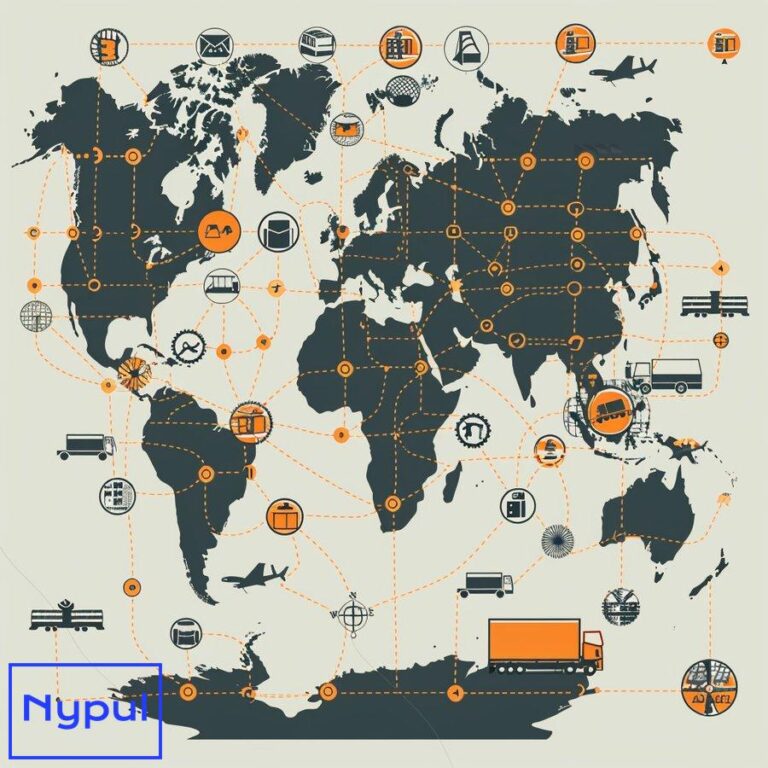What Are the Principles of Good Route Planning
Why is route planning crucial for logistics efficiency?
Route planning is the backbone of logistics efficiency. It determines the most optimal path for transporting goods from point A to point B, taking into account various factors such as distance, time, cost, and resource constraints. Efficient route planning not only saves time and money but also ensures the timely delivery of goods to customers.
One of the primary reasons why route planning is crucial for logistics efficiency is the ability to minimize transportation costs. By optimizing routes, companies can reduce fuel consumption, maintenance costs, and labor expenses associated with driving. This directly impacts the bottom line and helps maintain profitability in a highly competitive market.
Moreover, effective route planning contributes to improved customer satisfaction. By delivering goods on time and in good condition, companies build trust and loyalty with their customers. This, in turn, leads to repeat business and positive word-of-mouth, which are essential for long-term success in the logistics industry.
Route planning also plays a significant role in reducing environmental impact. By minimizing the number of miles driven and optimizing fuel efficiency, companies can lower their carbon footprint and contribute to a more sustainable future. This aligns with the growing trend of corporate social responsibility and can be a differentiating factor for eco-conscious consumers.
How can data drive better route planning decisions?
Data is the lifeblood of effective route planning. By collecting and analyzing various data points, logistics companies can make informed decisions that optimize their operations. Here are some ways in which data can drive better route planning decisions:
Historical data analysis: By studying historical route data, such as travel times, traffic patterns, and delivery success rates, companies can identify trends and patterns that inform future route planning decisions. This helps anticipate potential bottlenecks and proactively address them.
Real-time data integration: Integrating real-time data sources, such as traffic updates, weather forecasts, and vehicle telematics, allows companies to make dynamic adjustments to routes based on changing conditions. This helps minimize delays and ensure on-time deliveries.
Customer data utilization: Analyzing customer data, such as order history, delivery preferences, and feedback, can help companies tailor routes to meet specific customer needs. This personalized approach can lead to increased customer satisfaction and loyalty.
Predictive analytics: By leveraging predictive analytics, companies can forecast future demand and plan routes accordingly. This helps ensure that resources are allocated efficiently and that capacity is optimized to meet expected volumes.
Collaborative data sharing: Encouraging data sharing among logistics partners, such as carriers, shippers, and third-party providers, can lead to more comprehensive and accurate route planning. This collaborative approach helps identify inefficiencies and opportunities for optimization across the entire supply chain.
What strategies optimize routes for time and distance?
Optimizing routes for time and distance is crucial for maximizing logistics efficiency. Here are some key strategies that can help achieve this:
Vehicle routing problem (VRP) optimization: VRP optimization algorithms use mathematical models to determine the most efficient routes for a fleet of vehicles. These algorithms take into account factors such as vehicle capacity, customer locations, and time windows to minimize total distance traveled and delivery times.
Multimodal transportation: Combining different modes of transportation, such as trucks, trains, and ships, can help optimize routes for both time and distance. By leveraging the strengths of each mode, companies can create more efficient and cost-effective transportation solutions.
Backhaul optimization: Backhaul optimization involves arranging for vehicles to pick up goods on their return trip, reducing empty miles and improving overall efficiency. This strategy helps maximize vehicle utilization and reduces the need for additional transportation resources.
Route segmentation: Dividing routes into smaller, more manageable segments can help optimize for both time and distance. By breaking down routes into specific zones or regions, companies can better accommodate customer needs and adjust to changing conditions more effectively.
Dynamic route optimization: Dynamic route optimization uses real-time data and algorithms to continuously adjust routes based on changing conditions. This helps minimize delays, reduce travel times, and optimize for distance by taking into account factors such as traffic, weather, and vehicle status.
How does flexibility improve route planning outcomes?
Flexibility is a key factor in effective route planning. By incorporating flexibility into their processes, logistics companies can adapt to changing circumstances and optimize outcomes. Here are some ways in which flexibility improves route planning:
Ability to accommodate last-minute changes: Flexible route planning allows companies to quickly adjust routes to accommodate last-minute changes, such as new orders, priority shipments, or unexpected delays. This helps maintain customer satisfaction and ensures that goods are delivered on time.
Improved responsiveness to disruptions: When unexpected disruptions occur, such as road closures, weather events, or vehicle breakdowns, flexible route planning enables companies to quickly reroute vehicles and minimize the impact on deliveries. This helps maintain operational continuity and reduces the risk of costly delays.
Enhanced resource utilization: Flexible route planning allows companies to better utilize their resources, such as vehicles and drivers. By adjusting routes based on availability and capacity, companies can maximize efficiency and reduce the need for additional resources.
Increased scalability: Flexible route planning enables companies to scale their operations up or down based on demand. This helps ensure that resources are allocated efficiently and that capacity is optimized to meet expected volumes.
Improved collaboration with partners: Flexible route planning encourages collaboration with logistics partners, such as carriers, shippers, and third-party providers. By working together to adapt to changing circumstances, companies can create more efficient and effective transportation solutions.
What role do customer needs play in effective route planning?
Customer needs are at the heart of effective route planning. By understanding and addressing customer requirements, logistics companies can create transportation solutions that meet their needs and exceed their expectations. Here are some ways in which customer needs impact route planning:
Delivery time windows: Customer-specified delivery time windows are a critical factor in route planning. Companies must ensure that routes are designed to accommodate these windows and minimize the risk of late deliveries.
Specialized handling requirements: Some customers may have specialized handling requirements for their goods, such as temperature control, fragility, or hazardous materials. Route planning must take these requirements into account and ensure that vehicles and drivers are equipped to handle them safely and efficiently.
Pickup and drop-off locations: Customer locations, including pickup and drop-off points, are essential considerations in route planning. Companies must optimize routes to minimize travel time and distance while ensuring that all customer locations are served efficiently.
Recurring deliveries: Many customers require recurring deliveries on a daily, weekly, or monthly basis. Route planning must account for these recurring deliveries and ensure that they are integrated seamlessly into the overall transportation plan.
Customer feedback and preferences: Customer feedback and preferences play a crucial role in route planning. By actively seeking and incorporating customer input, companies can tailor their transportation solutions to better meet customer needs and improve overall satisfaction.
How can resource constraints be balanced in route planning?
Resource constraints are a reality in logistics, and effective route planning requires balancing these constraints to optimize efficiency. Here are some ways in which resource constraints can be balanced in route planning:
Vehicle capacity optimization: By optimizing vehicle capacity, companies can ensure that goods are transported efficiently while minimizing the number of vehicles required. This helps reduce fuel costs, maintenance expenses, and labor costs associated with driving.
Driver scheduling and dispatch: Effective driver scheduling and dispatch are critical for balancing resource constraints in route planning. Companies must ensure that drivers are available when needed, that they are assigned to routes that match their skills and experience, and that they are provided with clear instructions and support.
Warehouse and distribution center optimization: Optimizing the location and capacity of warehouses and distribution centers can help balance resource constraints in route planning. By strategically placing these facilities, companies can reduce travel distances, improve delivery times, and better utilize their transportation resources.
Collaboration with partners: Collaborating with logistics partners, such as carriers, shippers, and third-party providers, can help balance resource constraints in route planning. By sharing resources and expertise, companies can create more efficient and cost-effective transportation solutions.
Continuous improvement: Continuously monitoring and analyzing resource constraints and their impact on route planning can help identify opportunities for improvement. By making data-driven decisions and implementing best practices, companies can optimize their use of resources and improve overall efficiency.
Which technologies enhance route planning capabilities?
Technology plays a crucial role in enhancing route planning capabilities. By leveraging the power of data and automation, logistics companies can create more efficient and effective transportation solutions. Here are some technologies that enhance route planning capabilities:
Geographic Information Systems (GIS): GIS technology provides detailed maps and spatial data that can be used to optimize routes based on factors such as distance, travel time, and road conditions. This helps minimize travel distances and improve delivery times.
Telematics: Vehicle telematics systems collect real-time data on vehicle location, speed, and performance. This data can be used to monitor driver behavior, optimize routes, and identify opportunities for improvement.
Artificial Intelligence (AI) and Machine Learning (ML): AI and ML algorithms can analyze large amounts of data and identify patterns and trends that inform route planning decisions. These technologies can help predict demand, optimize routes, and identify potential bottlenecks.
Route optimization software: Specialized route optimization software uses advanced algorithms to determine the most efficient routes for a fleet of vehicles. These solutions take into account factors such as vehicle capacity, customer locations, and time windows to minimize total distance traveled and delivery times.
Mobile apps and devices: Mobile apps and devices, such as smartphones and tablets, can be used to communicate with drivers and provide real-time updates on route progress and delivery status. This helps improve communication and collaboration between drivers and dispatchers.
What KPIs should be tracked to improve route planning?
Key Performance Indicators (KPIs) are essential for measuring the effectiveness of route planning and identifying areas for improvement. Here are some KPIs that should be tracked to improve route planning:
On-time delivery rate: The percentage of deliveries made within the specified time window is a critical measure of route planning effectiveness. This KPI helps identify areas where routes need to be optimized to improve delivery times.
Miles per gallon (MPG): Tracking the average fuel efficiency of vehicles can help identify opportunities for improvement in route planning. By optimizing routes to minimize unnecessary idling and reduce travel distances, companies can improve MPG and reduce fuel costs.
Delivery success rate: The percentage of deliveries that are successfully completed on the first attempt is a key measure of route planning effectiveness. This KPI helps identify areas where routes need to be adjusted to accommodate customer needs and reduce the risk of failed deliveries.
Driver productivity: Measuring driver productivity, such as the number of deliveries made per day or the average time spent on the road, can help identify opportunities for improvement in route planning and driver scheduling.
Customer satisfaction: Tracking customer satisfaction through surveys, feedback, and repeat business can help measure the overall effectiveness of route planning. This KPI helps ensure that transportation solutions are meeting customer needs and exceeding their expectations.
How do compliance and safety regulations impact route planning?
Compliance and safety regulations are critical considerations in route planning. Logistics companies must ensure that their transportation solutions adhere to all relevant laws and regulations while prioritizing the safety of drivers, vehicles, and the general public. Here are some ways in which compliance and safety regulations impact route planning:
Vehicle maintenance and inspection: Route planning must account for regular vehicle maintenance and inspection to ensure compliance with safety regulations. This includes scheduling maintenance, tracking vehicle history, and ensuring that vehicles are in good working order before being dispatched.
Driver training and certification: Route planning must consider driver training and certification requirements to ensure compliance with regulations and promote safe driving practices. This includes providing drivers with training on topics such as defensive driving, hazardous materials handling, and emergency response procedures.
Route restrictions and hazards: Route planning must take into account route restrictions and hazards, such as weight limits, height restrictions, and dangerous road conditions. By identifying and avoiding these restrictions and hazards, companies can ensure compliance with regulations and minimize the risk of accidents or incidents.
Hazardous materials handling: For shipments involving hazardous materials, route planning must adhere to strict regulations and safety protocols. This includes selecting appropriate vehicles, training drivers on proper handling procedures, and ensuring that all necessary documentation and placards are in place.
Hours of service (HOS) regulations: Route planning must comply with HOS regulations, which limit the number of hours that drivers can operate a vehicle in a given period. By ensuring that routes are designed to accommodate these regulations, companies can promote driver safety and avoid costly penalties for non-compliance.





